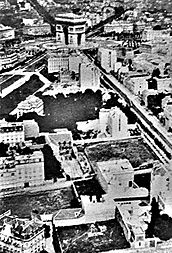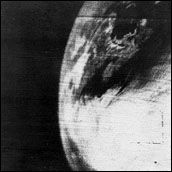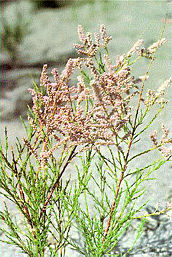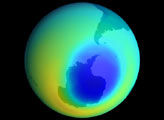

 | by Laurie J. Schmidt January 12, 2001 | ||
| In the
heat of the 1962 Cuban Missile Crisis, the Kennedy administration
released aerial photos of Soviet missiles in Cuba taken from
high-altitude airplanes. Following the crisis, both the United States
and the Soviet Union developed sophisticated satellites to monitor the
other's strategic forces. |
 Remote sensing began when Gaspard Felix Tournachon, known by his pseudonym Nadar, photographed a French village from a balloon. He took this aerial photo of Paris in 1867. (Image courtesy of USGS: Earthshots. A new browser window will open.)   The first television picture from space was taken by the TIROS-1 satellite in 1960. Although primitive by today's standards, it demonstrated satellite utility in monitoring weather. Click here for more information.  Native to Eurasia and Africa, Chinese Tamarisk, also known as Salt Cedar, was introduced as an ornamental shrub in the United States in the 19th century. Since then, it has become an invasive weed that forces out native vegetation. (Image courtesy of USGS)  Ozone hole over Antarctica, October 2000. Click here for larger image.  Landsat 5 image of Chernobyl taken on May 31, 1986, approximately one month after the nuclear accident. (Image courtesy of USGS: Earthshots. A new browser window will open.) For more information, visit the Socioeconomic Data and Applications Center. (A new browser window will open.) |
||
| "Those images shaped the course of the Cold War and demonstrated that remote sensing technologies could serve as powerful diplomatic tools," said David Sandalow, Assistant Secretary for Oceans and International Environmental and Scientific Affairs with the U.S. Department of State. Remote sensing technology, increasingly crucial to the understanding of Earth's climate and environmental processes, now permits the monitoring of global environmental conditions and the gathering of data that were historically unavailable. At the same time, the number of multilateral environmental agreements (MEAs), treaties negotiated between nations to promote environmental protection, has grown rapidly since the 1972 Stockholm Conference on the Environment. Experts say space-based Earth observations have great potential for shaping international environmental policy. But political leaders and researchers agree that serious scientific issues — and diplomatic risks — remain. "Remote sensing" refers to the collection of scientific data about the Earth's surface using instruments mounted on aircraft or satellites. Aerial views of the Earth's surface were first recorded via cameras mounted on tethered balloons as early as 1858, and aerial photography was routinely used for military reconnaissance during World War I. But a series of major developments, beginning in the 1960s, marked the beginning of the era of satellite imagery. The first experimental weather satellite, Television and Infrared Observation Satellite (TIROS-1), was launched in 1960. Designed to monitor cloud patterns, TIROS-1 set the stage for the development of land observation satellites. In 1972, NASA launched Landsat 1 ("Land Satellite 1"), the first in a series of satellites designed to provide systematic, serial images of Earth's land areas. Scientists use images from Landsat, now in its seventh generation, for global and regional environmental change research, as well as for other civil and commercial purposes. The most recent milestone in Earth observation activity, NASA's Earth Observing System (EOS), consists of a fleet of satellites specifically designed to study global change. The flagship of the EOS satellites, Terra, was launched on December 18, 1999. Five sensors aboard Terra collect data that provide information about how the Earth's lands, oceans, atmosphere, ice, and life function as an interdependent system. Terra's sister ship, Aqua, is scheduled to launch in late 2001. Since Landsat, satellites have provided continuous surveillance of the Earth's surface, and the number of remote sensing instruments orbiting the Earth is continually increasing. Today, more than a dozen countries use remote sensing technologies to address environmental issues both within their own and along shared borders. Uses range from the U.S. Agricultural Research Service's (ARS's) mapping of invasive Chinese Tamarisk in the southwestern states, to the survey of blue-green algae extent in the lower Laguna Madre area of South Padre Island by Texas biologists, to the identification of illegal coca crop cultivation in isolated regions of Latin America. But according to Sandalow, the unrealized benefits of remote sensing technologies are enormous. "Remote sensing plays a central role in the management of foreign policy, from arms control to protecting the environment and promoting public health," Sandalow said in a speech delivered last June at a symposium entitled "Viewing the Earth: The Role of Satellite Earth Observations and Global Monitoring in International Affairs." The powerful link between remote sensing and foreign policy was demonstrated in 1986 when a reactor exploded at the Chernobyl nuclear power plant in Ukraine. Images from Landsat and the French satellite SPOT (Le Systeme Pour l'Observation de la Terre) profoundly influenced public perception and international response to the disaster. Today, MEAs address almost every part of the Earth's biophysical systems, and many contain provisions for monitoring, reporting, and assessing environmental and behavioral data. The United Nations Framework Convention on Climate Change (UNFCCC), adopted in 1992, provides for the stabilization of greenhouse gas concentrations in the atmosphere at levels that prevent interference with the global climate system. The Convention on Wetlands of International Importance (Ramsar Convention), adopted in 1971, provides the framework for international conservation and wise use of wetlands. Other MEAs address issues such as deforestation, desertification, protection of marine areas and wildlife habitat, and biological diversity. But MEAs are not foolproof. For one thing, many environmental treaties lack enforcement mechanisms. "A state may be signatory to a treaty, but that doesn't mean it will necessarily submit to all its terms," said Alex de Sherbinin, Research Associate with the Socioeconomic Data and Applications Center (SEDAC) operated by Columbia University's Center for International Earth Science Information Network (CIESIN). During negotiation processes, states that want to dilute agreement terms tend to have a disproportionate influence on the outcome, according to Kal Raustiala, Assistant Professor in the School of Law and the Institute of the Environment at the University of California, Los Angeles. "Because MEAs are negotiated agreements, you typically see a process in which the treaty is slowly driven to the 'lowest common denominator,' to the point that the agreement may not be very effective," he said. Another shortcoming of MEAs involves the self-reporting aspect of the international legal system. "States often report on their own actions, rather than being monitored by others," said Raustiala. "Even under favorable conditions, such reports are often not filed on time or at all." "Because remote sensing provides a view from space of a whole range of environmental phenomena that are hard to detect on the ground," de Sherbinin said, "the availability of satellite imagery can encourage successful negotiation and enforcement of MEAs." For example, Mexico and Guatemala created a 4-million acre biosphere reserve in the 1980s, in part due to the influence of satellite imagery showing extensive rainforest destruction along their joint border. Earth observation data also played a major role in the recognition and monitoring of the changing stratospheric ozone over Antarctica. Reduced stratospheric ozone, caused by increased chlorofluorocarbon (CFC) concentrations, permits higher amounts of ultraviolet radiation to enter the Earth's atmosphere, thereby posing risks to humans and ecosystems. Media attention to satellite images of the "ozone hole" heightened public concern about ozone depletion, leading to the Montreal Protocol on Substances that Deplete the Ozone Layer, a 1987 treaty in which 24 nations agreed to cut CFC emissions by about 35 percent between 1989 and 2000. "In the not-so-distant future, remote sensing may also help us monitor compliance with environmental agreements and treaties." Sandalow said. "For example, satellite data could help assess carbon stocks and sinks, or identify vessels engaged in illegal fishing." Raustiala concurred, "Used as a deterrent form of monitoring, remote sensing capabilities may persuade states and other relevant actors to comply with the terms of an MEA out of fear of discovery," he said. Raustiala and Sandalow each suggested that the most important application of remote sensing science to MEAs might be its use in environmental assessments. For example, Raustiala cited the international environmental assessment process undertaken by the Intergovernmental Panel on Climate Change (IPCC), which is influential because it rests on the scientific expertise of more than a thousand worldwide members from diverse scientific disciplines. "Because environmental assessments, such as the IPCC, are more closely linked to scientific data than other aspects of international environmental cooperation, they may ultimately provide the most important input for remote sensing data," he said. "One of the best-known forest assessment activities, Brazil's program to monitor the extent and rate of deforestation in the Amazon rainforest, relies heavily on satellite data," Sandalow said. However, both experts emphasized that the use of remote sensing in the context of MEAs is far from a simple matter. "Environmental agreements are complex instruments negotiated between governments that individually have very different goals and objectives in signing them," said de Sherbinin. "And, most states have a traditional tendency to protect their decision-making rights within their national territory." Sovereignty, the right that frees nations from external control by other states, is tied to a state's territory, which includes its airspace and portions of ocean adjacent to coasts. "In a legal sense, remote sensing technologies do not violate sovereignty, but politically they may be perceived to do so," Raustiala said. According to de Sherbinin, there is also concern that remote sensing technologies may be used to the advantage of industrialized countries. "Interpretation of remote sensing images requires a lot of technical ability, and there is a technological gap between developing countries and industrialized nations," he said. "High-resolution imagery simply isn't affordable for many potential users, including some government agencies," said Sandalow. Also present is the danger of imagery misinterpretation. "Satellite images have the potential, if misinterpreted, to increase tensions among nations and create confusion during periods of crisis," Sandalow said. Misinterpretation is not just a theoretical problem: in one incident, an image proclaimed by a magazine to be the site of India's 1998 nuclear test turned out to be a livestock pen, according to Sandalow. "Without adequate experience and training, it can be relatively easy to see proof of sinister intent in a benign image, or to miss details that would be obvious to a knowledgeable photo interpreter," he said. Also, de Sherbinin pointed out that the science has yet to be fully developed and tested, for example, in relation to carbon sinks under the Kyoto Protocol of the UNFCCC. "Measuring carbon density remotely is not simply a matter of taking snapshots in space and then estimating the tons of biomass in a hectare of forest," he said. But numerous efforts are under way to promote the use of remote sensing in environmental agreements, and to address obstacles. SEDAC held a workshop on December 4-5, 2000 entitled "Remote Sensing and Environmental Treaties: Building More Effective Linkages." The two-day workshop, held in Washington, D.C., was the first to specifically address remote sensing applications for MEAs and featured thematic sessions focusing on biodiversity and ecosystem management, atmospheric pollution and climate change, and institutional and remote sensing instrument design. "The basic idea was to bring together communities of remote sensing and international policy experts to initiate a dialogue between them," said de Sherbinin, the workshop organizer. "Many diplomats who negotiate treaties don't realize what's out there in terms of remote sensing technology, and the remote sensing community is generally unaware of treaty-specific needs." Also, dramatic changes in satellite technologies are on the horizon, according to Sandalow. At least three companies now market Earth imagery products with an eye towards capturing some of the national security, scientific, and environmental monitoring markets. Space Imaging, a Colorado-based company, launched their first satellite (Ikonos) in 1999, and Orbimage of Virginia plans to launch its own high-resolution satellite in May 2001. Data from Ikonos proved useful in assessing damage to the site of Los Alamos National Laboratory after New Mexico's Cerro Grande fire last May. Raustiala believes that commercial remote sensing vendors could play an important role in the MEA process. "Private vendors will be able to supply special interest groups, environmental organizations, and the media with a separate degree of information than government vendors," he said. "That could be powerful in terms of the politics of these agreements." "As the severity of international environmental problems increases, states are becoming more willing to relinquish some of their sovereignty and submit to these agreements," said de Sherbinin. The U.S. State Department has commissioned a comprehensive study, to be conducted jointly by the National Research Council's Office of International Affairs and the Space Studies Board, to investigate how remote sensing technology can best serve foreign policy objectives. One of the study's goals is to examine the steps required to increase the number of expert imagery analysts, Sandalow said. Sandalow said the State Department's Bureau of Scientific Affairs also plans to invest half a million dollars in regional workshops to promote space applications in Africa, Latin America, Asia, and Eastern Europe. "An important component of these workshops will be the dissemination of geospatial technologies that use remote sensing data," he said. As Earth observation technology advances and grows, data policy will become increasingly important. "The challenge is to promote the beneficial applications of remote sensing while also managing the risks," said Sandalow. "There has to be a healthy realism about what can be attained through environmental agreements," said de Sherbinin, adding that a lot depends on national-level environmental laws. "Remote sensing is not going to be the sole solution, but it's an important step along the way." Hardin, B. 1999. Remote sensing keeps an eye on natural resources. Agricultural Research, 47, p. 8. Kline, K. and K. Raustiala. 2000. International environmental agreements and remote sensing technologies. Background paper prepared for the Workshop on Remote Sensing and Environmental Treaties: Building More Effective Linkages, December 4-5, 2000. Sandalow, D.B. 2000. Remote sensing and foreign policy. Paper read at Symposium on Viewing the Earth: The Role of Satellite Earth Observations and Global Monitoring in International Affairs, June 6, 2000, at George Washington University, Washington, D.C. This article contributed by NASA's Distributed Active Archive Centers (DAACs). For more information visit http://nasadaacs.eos.nasa.gov/ | |||